Sága, a Deep Learning Spectral Analysis Tool for Fungal Detection in Grains—A Case Study to Detect Fusarium in Winter Wheat
Abstract
1. Introduction
2. Results
2.1. Wheat Ear Detection and Segmentation
2.2. Spectral Response Difference in the Infected Wheat Ear and Healthy Ear
2.3. Predictive Model Result
3. Discussion
4. Conclusions
5. Method
5.1. Field Experiments
5.2. Image Data Acquisition and Data Pre-Processing
5.3. Model Development
5.3.1. Wheat Ear Detection and Segmentation
5.3.2. Predictive Model Based on Spectral Information of Wheat Ear
Author Contributions
Funding
Institutional Review Board Statement
Informed Consent Statement
Data Availability Statement
Acknowledgments
Conflicts of Interest
Appendix A
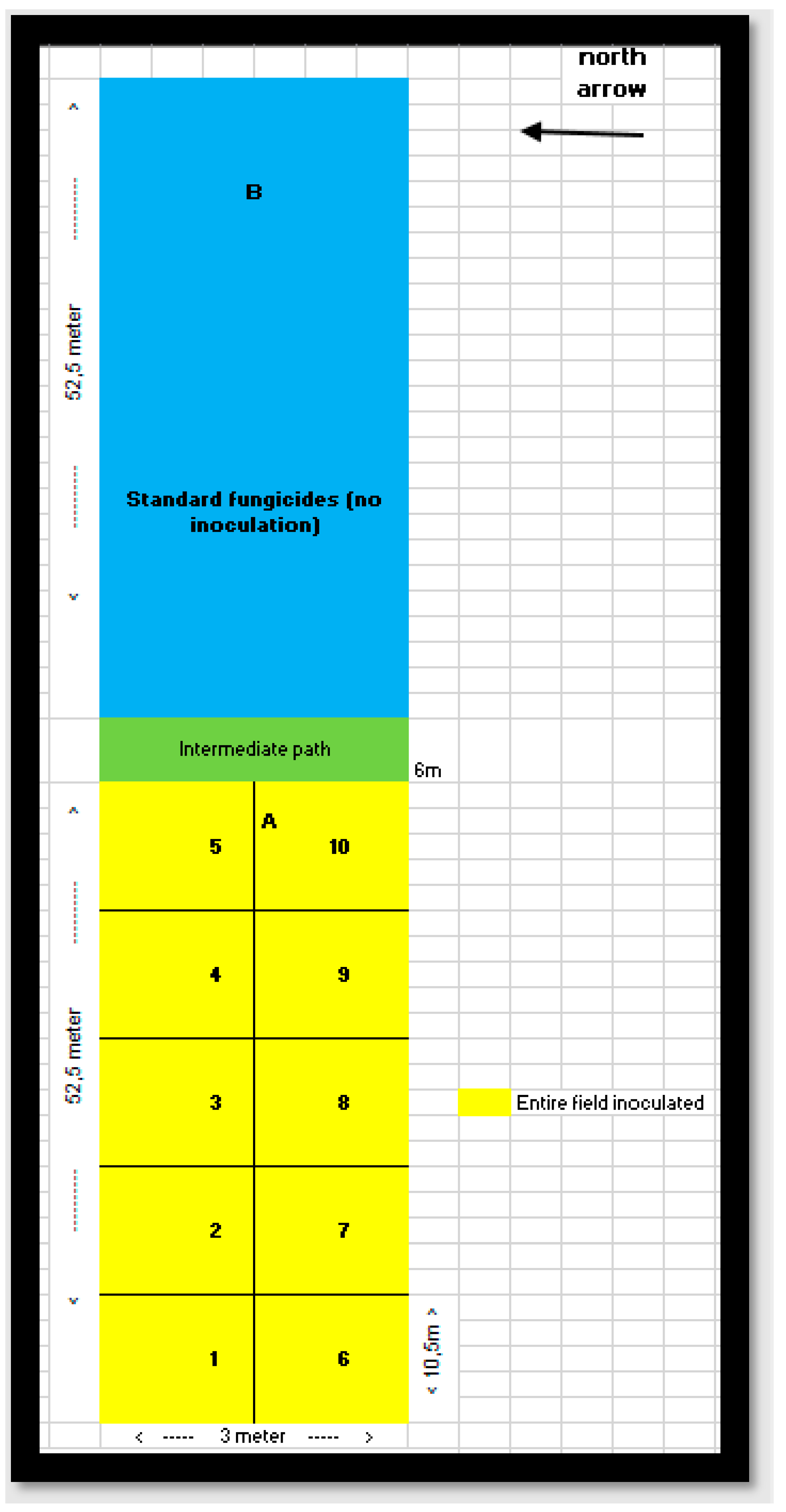
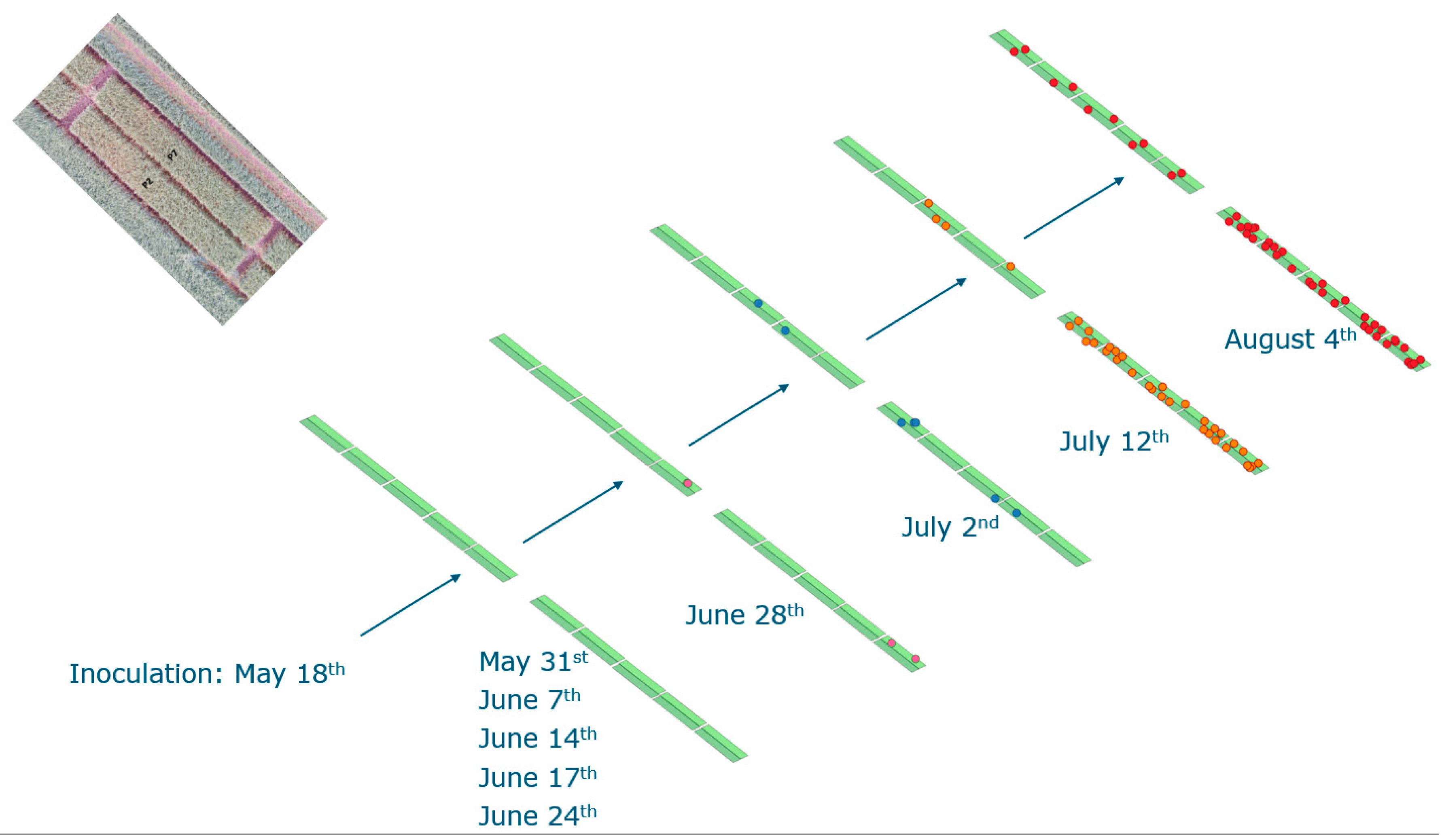
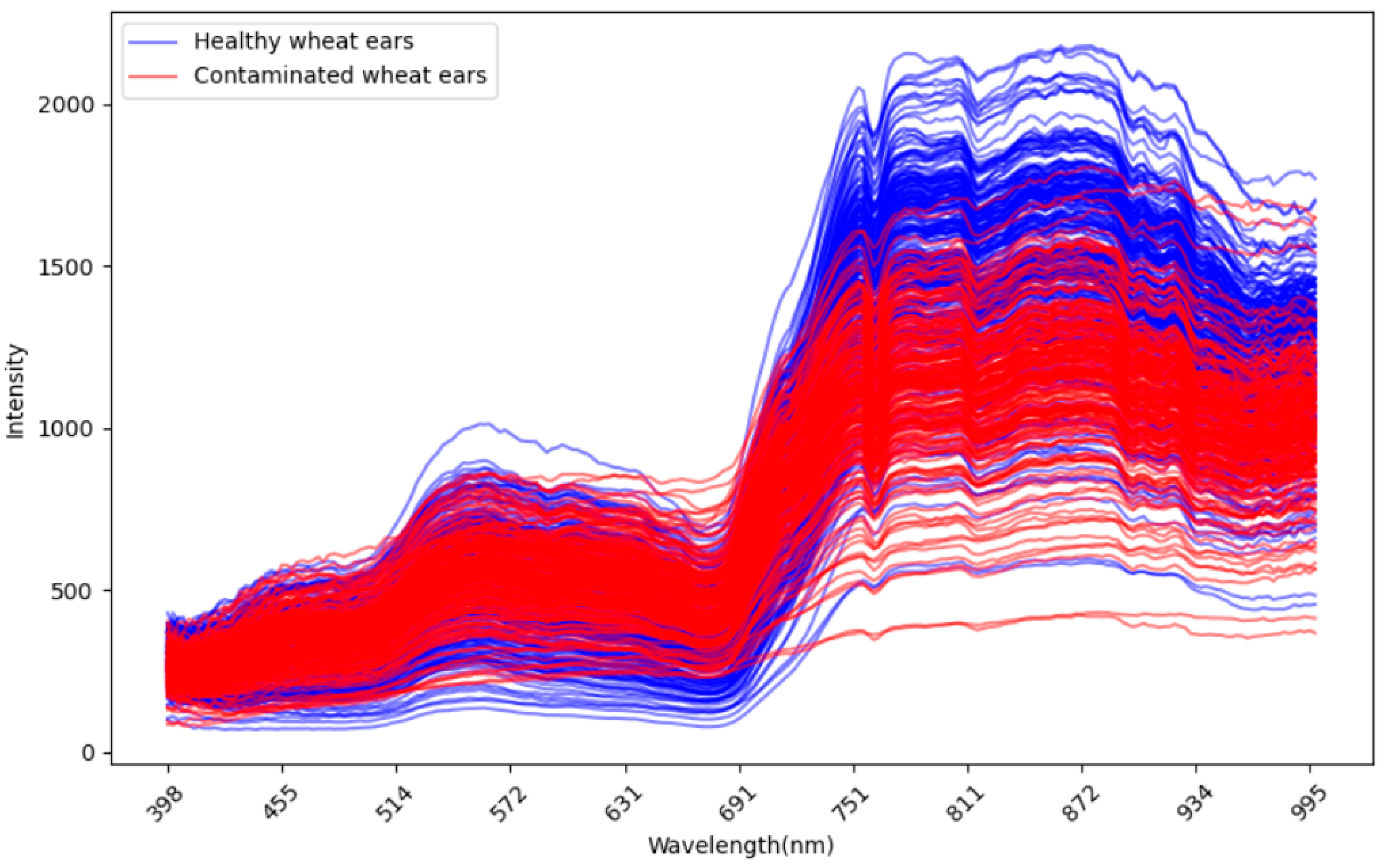
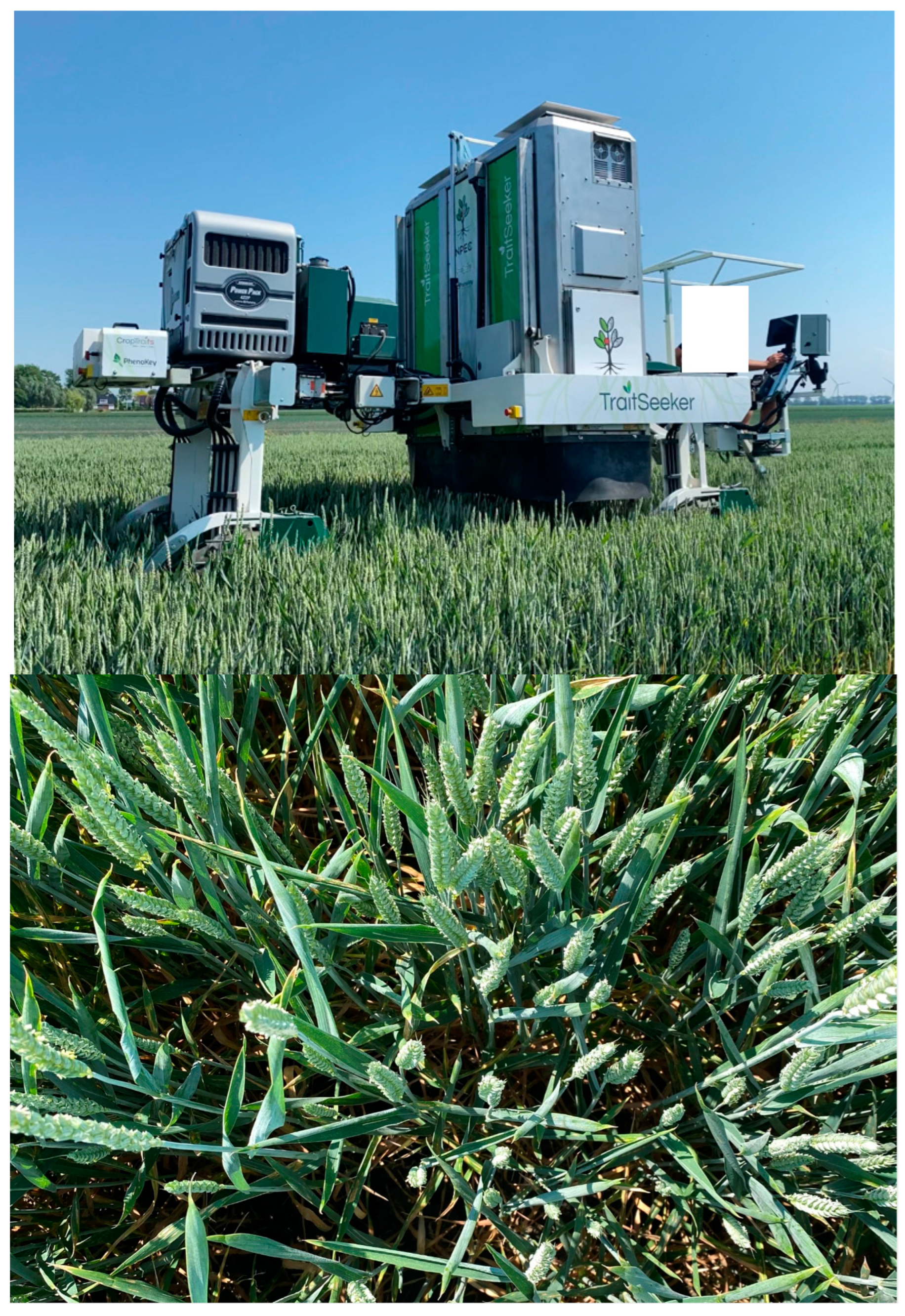
References
- Bekele, B.; Dawit, W. Review on the status and management strategies of Fusarium head blight (Fusarium graminearum) of wheat. Acad. Res. J. Agric. Sci. Res. 2018, 6, 77–88. [Google Scholar]
- Mielniczuk, E.; Skwaryło-Bednarz, B. Fusarium head blight, mycotoxins and strategies for their reduction. Agronomy 2020, 10, 509. [Google Scholar] [CrossRef]
- Ferrigo, D.; Raiola, A.; Causin, R. Fusarium toxins in cereals: Occurrence, legislation, factors promoting the appearance and their management. Molecules 2016, 21, 627. [Google Scholar] [CrossRef]
- da Rocha, M.E.B.; Freire, F.d.C.O.; Maia, F.E.F.; Guedes, M.I.F.; Rondina, D. Mycotoxins and their effects on human and animal health. Food Control. 2014, 36, 159–165. [Google Scholar] [CrossRef]
- Xia, R.; Schaafsma, A.; Wu, F.; Hooker, D. Impact of the improvements in Fusarium head blight and agronomic management on economics of winter wheat. World Mycotoxin J. 2020, 13, 423–439. [Google Scholar] [CrossRef]
- Wilson, W.; Dahl, B.; Nganje, W. Economic costs of Fusarium Head Blight, scab and deoxynivalenol. World Mycotoxin J. 2018, 11, 291–302. [Google Scholar] [CrossRef]
- Marchand, P.A.; Robin, D. Evolution of Directive (EC) No 128/2009 of the European Parliament and of the Council establishing a framework for Community action to achieve the sustainable use of pesticides. J. Regul. Sci. 2019, 7, 1–7. [Google Scholar] [CrossRef]
- Bauriegel, E.; Giebel, A.; Geyer, M.; Schmidt, U.; Herppich, W. Early detection of Fusarium infection in wheat using hyper-spectral imaging. Comput. Electron. Agric. 2011, 75, 304–312. [Google Scholar] [CrossRef]
- Weber, V.; Araus, J.L.; Cairns, J.E.; Sanchez, C.; Melchinger, A.E.; Orsini, E. Prediction of grain yield using reflectance spectra of canopy and leaves in maize plants grown under different water regimes. Field Crops Res. 2012, 128, 82–90. [Google Scholar] [CrossRef]
- Liu, L.; Dong, Y.; Huang, W.; Du, X.; Ma, H. Monitoring wheat fusarium head blight using unmanned aerial vehicle hyperspectral imagery. Remote Sens. 2020, 12, 3811. [Google Scholar] [CrossRef]
- Zhang, N.; Pan, Y.; Feng, H.; Zhao, X.; Yang, X.; Ding, C.; Yang, G. Development of Fusarium head blight classification index using hyperspectral microscopy images of winter wheat spikelets. Biosyst. Eng. 2019, 186, 83–99. [Google Scholar] [CrossRef]
- Rieker, M.E.; Lutz, M.A.; El-Hasan, A.; Thomas, S.; Voegele, R.T. Hyperspectral Imaging and Selected Biological Control Agents for the Management of Fusarium Head Blight in Spring Wheat. Plants 2023, 12, 3534. [Google Scholar] [CrossRef] [PubMed]
- Thomas, S.; Kuska, M.T.; Bohnenkamp, D.; Brugger, A.; Alisaac, E.; Wahabzada, M.; Behmann, J.; Mahlein, A.-K. Benefits of hyperspectral imaging for plant disease detection and plant protection: A technical perspective. J. Plant Dis. Prot. 2018, 125, 5–20. [Google Scholar] [CrossRef]
- Su, W.-H.; Zhang, J.; Yang, C.; Page, R.; Szinyei, T.; Hirsch, C.D.; Steffenson, B.J. Automatic evaluation of wheat resistance to fusarium head blight using dual mask-RCNN deep learning frameworks in computer vision. Remote Sens. 2020, 13, 26. [Google Scholar] [CrossRef]
- Bao, W.; Yang, X.; Liang, D.; Hu, G.; Yang, X. Lightweight convolutional neural network model for field wheat ear disease identification. Comput. Electron. Agric. 2021, 189, 106367. [Google Scholar] [CrossRef]
- Lu, J.; Hu, J.; Zhao, G.; Mei, F.; Zhang, C. An in-field automatic wheat disease diagnosis system. Comput. Electron. Agric. 2017, 142, 369–379. [Google Scholar] [CrossRef]
- Gao, C.; Ji, X.; He, Q.; Gong, Z.; Sun, H.; Wen, T.; Guo, W. Monitoring of Wheat Fusarium Head Blight on Spectral and Textural Analysis of UAV Multispectral Imagery. Agriculture 2023, 13, 293. [Google Scholar] [CrossRef]
- Dandrifosse, S.; Ennadifi, E.; Carlier, A.; Gosselin, B.; Dumont, B.; Mercatoris, B. Deep learning for wheat ear segmentation and ear density measurement: From heading to maturity. Comput. Electron. Agric. 2022, 199, 107161. [Google Scholar] [CrossRef]
- Bauriegel, E.; Giebel, A.; Herppich, W.B. Hyperspectral and chlorophyll fluorescence imaging to analyse the impact of Fusarium culmorum on the photosynthetic integrity of infected wheat ears. Sensors 2011, 11, 3765–3779. [Google Scholar] [CrossRef]
- Polder, G.; Van Der Heijden, G.; Waalwijk, C.; Young, I. Detection of Fusarium in single wheat kernels using spectral imaging. Seed Sci. Technol. 2005, 33, 655–668. [Google Scholar] [CrossRef]
- Zhang, D.; Wang, Q.; Lin, F.; Yin, X.; Gu, C.; Qiao, H. Development and evaluation of a new spectral disease index to detect wheat fusarium head blight using hyperspectral imaging. Sensors 2020, 20, 2260. [Google Scholar] [CrossRef] [PubMed]
- Dammer, K.-H.; Möller, B.; Rodemann, B.; Heppner, D. Detection of head blight (Fusarium ssp.) in winter wheat by color and multispectral image analyses. Crop Prot. 2011, 30, 420–428. [Google Scholar]
- Zhang, H.; Huang, L.; Huang, W.; Dong, Y.; Weng, S.; Zhao, J.; Ma, H.; Liu, L. Detection of wheat Fusarium head blight using UAV-based spectral and image feature fusion. Front. Plant Sci. 2022, 13, 1004427. [Google Scholar] [CrossRef] [PubMed]
- Li, Y.; Cao, G.; Liu, D.; Zhang, J.; Li, L.; Chen, C. Determination of Wheat Heading Stage Using Convolutional Neural Networks on Multispectral UAV Imaging Data. Comput. Intell. Neurosci. 2022, 2022, 3655804. [Google Scholar] [CrossRef] [PubMed]
- Polder, G.; Gowen, A. The hype in spectral imaging. Spectrosc. Eur. 2021, 9, a4. [Google Scholar] [CrossRef]
- David, E.; Ogidi, F.; Smith, D.; Chapman, S.; de Solan, B.; Guo, W.; Baret, F.; Stavness, I. Global wheat head detection challenges: Winning models and application for head counting. Plant Phenomics 2023, 5, 0059. [Google Scholar] [CrossRef]
- David, E.; Serouart, M.; Smith, D.; Madec, S.; Velumani, K.; Liu, S.; Wang, X.; Pinto, F.; Shafiee, S.; Tahir, I.S. Global wheat head detection 2021: An improved dataset for benchmarking wheat head detection methods. Plant Phenomics 2021, 2021, 9846158. [Google Scholar] [CrossRef]
- Wyszecki, G.; Stiles, W.S. Color Science: Concepts and Methods, Quantitative Data and Formulae; John Wiley & Sons: New York, NY, USA, 2000; Volume 40. [Google Scholar]
- Chen, T.; He, T.; Benesty, M.; Khotilovich, V.; Tang, Y.; Cho, H.; Chen, K.; Mitchell, R.; Cano, I.; Zhou, T. Xgboost: Extreme Gradient Boosting. R Package Version 0.4-2. 2015. [Google Scholar]
- Pal, K.; Patel, B.V. Data classification with k-fold cross validation and holdout accuracy estimation methods with 5 different machine learning techniques. In Proceedings of the 2020 Fourth International Conference on Computing Methodologies and Communication (ICCMC), Erode, India, 11–13 March 2020; pp. 83–87. [Google Scholar]
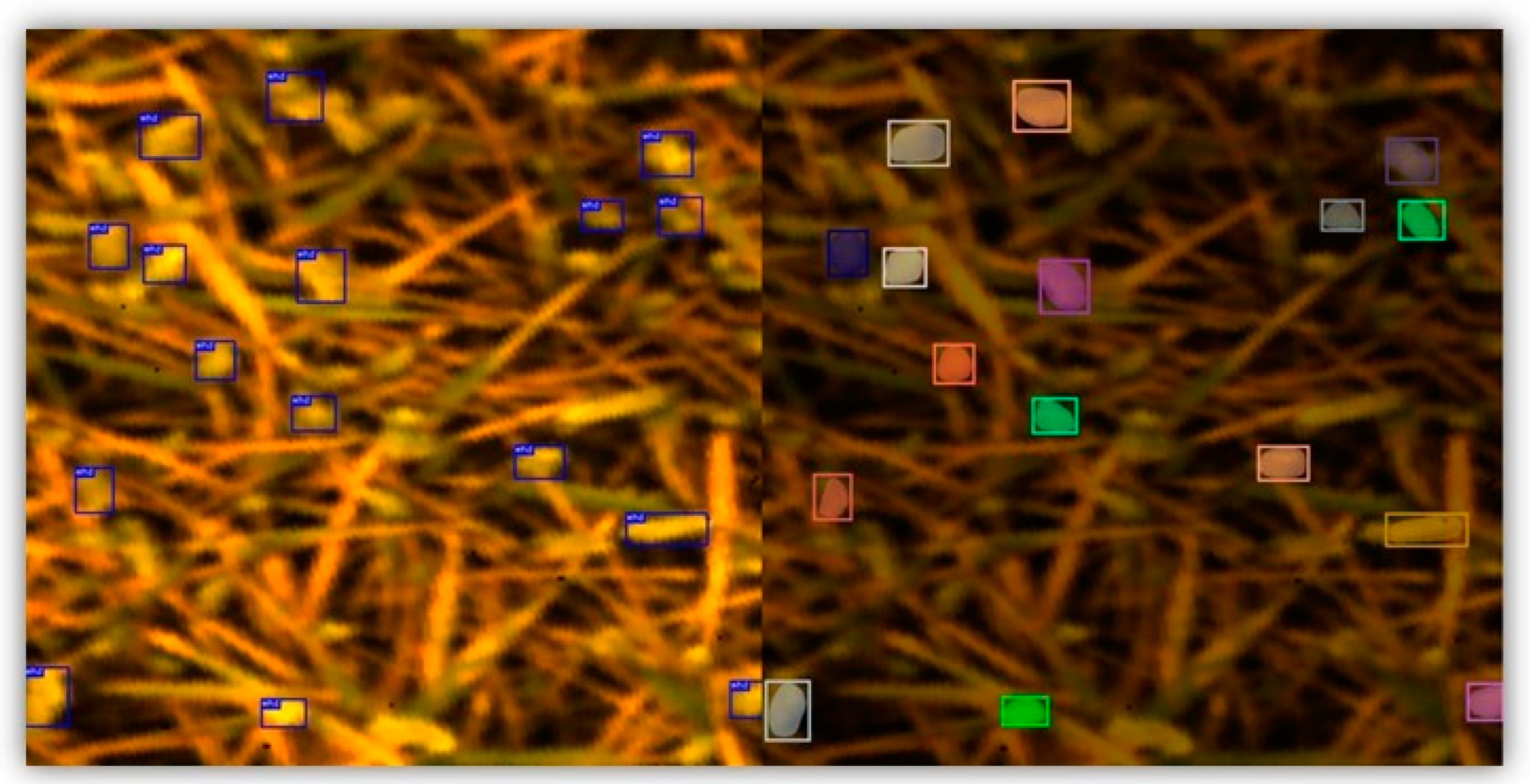
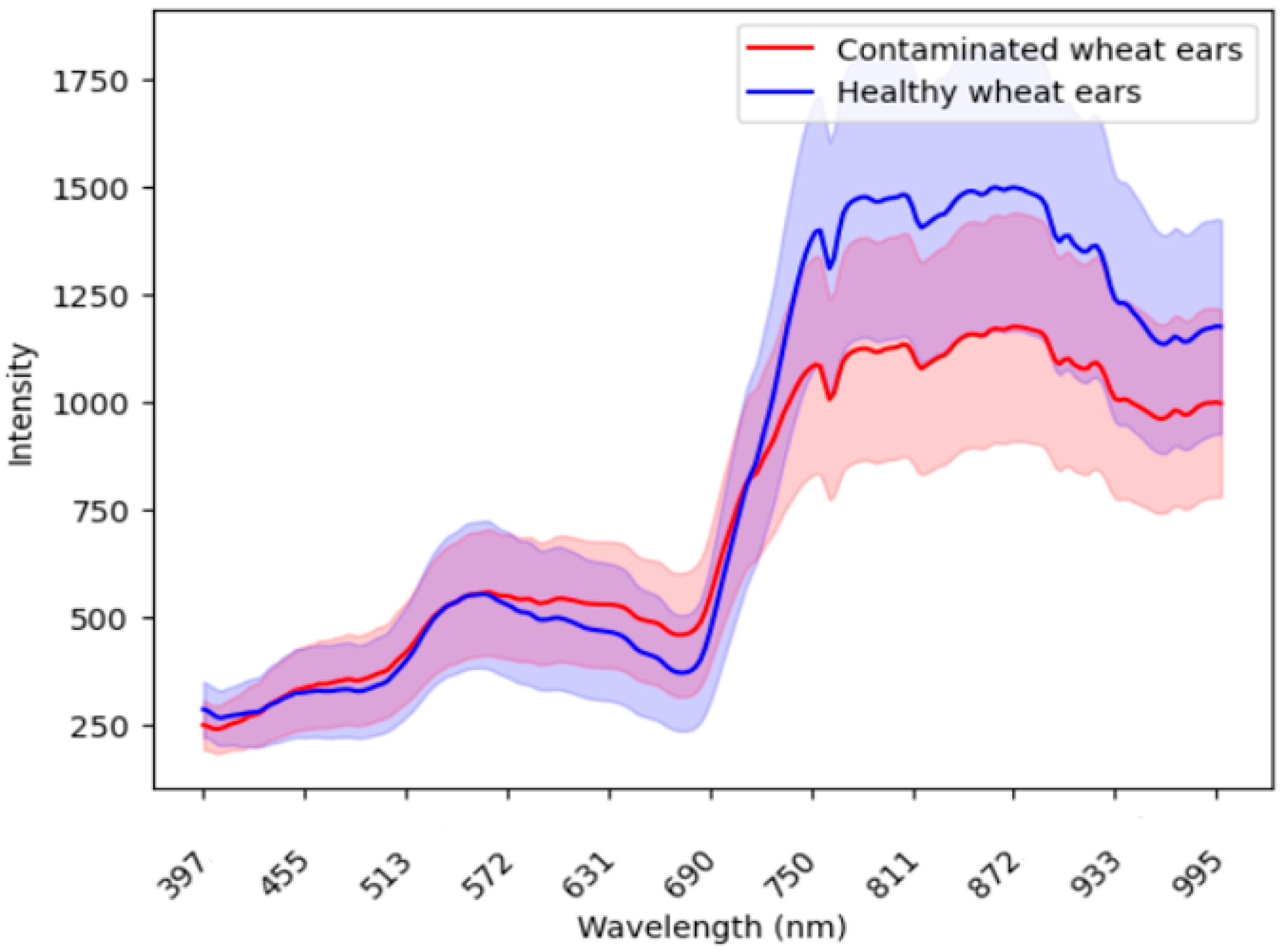
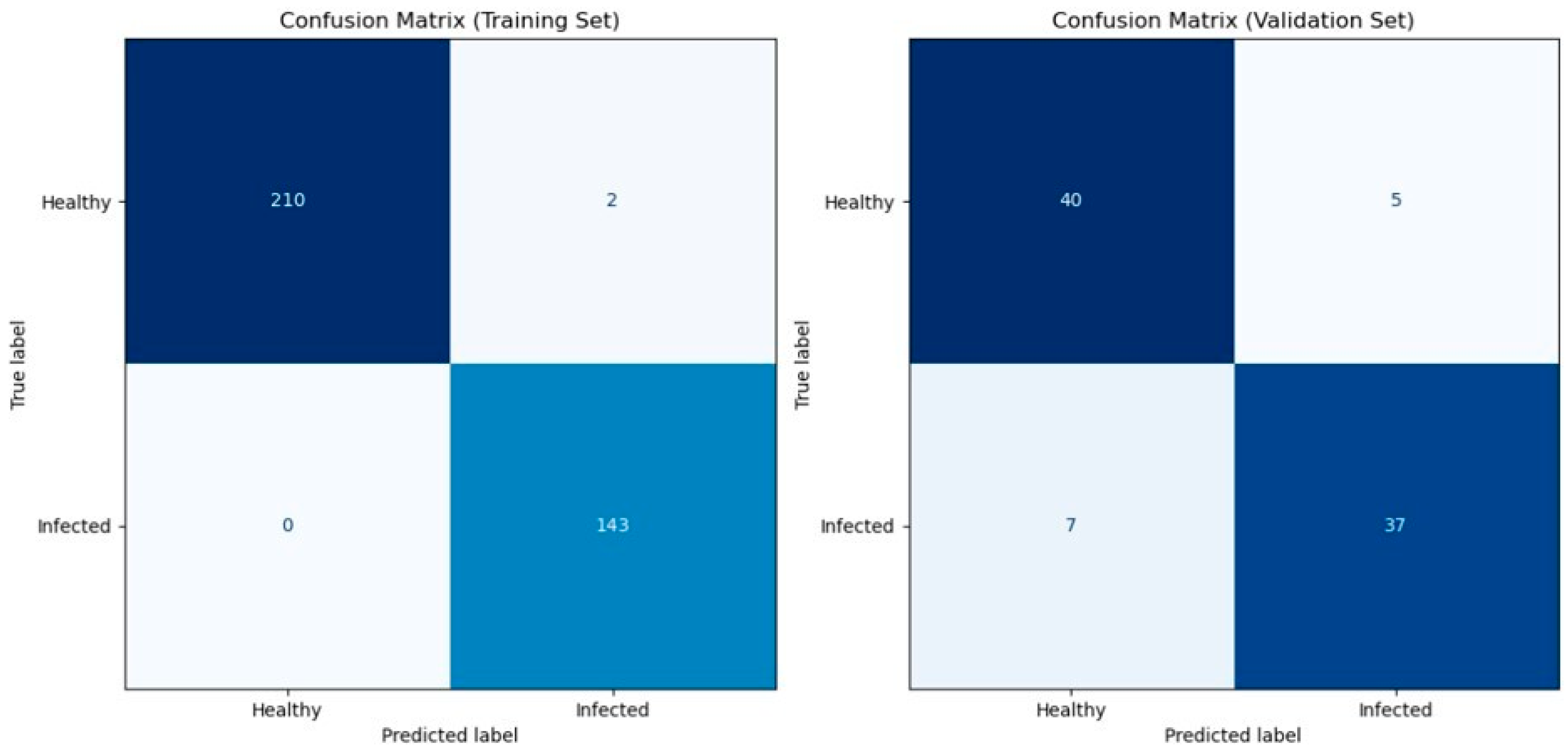
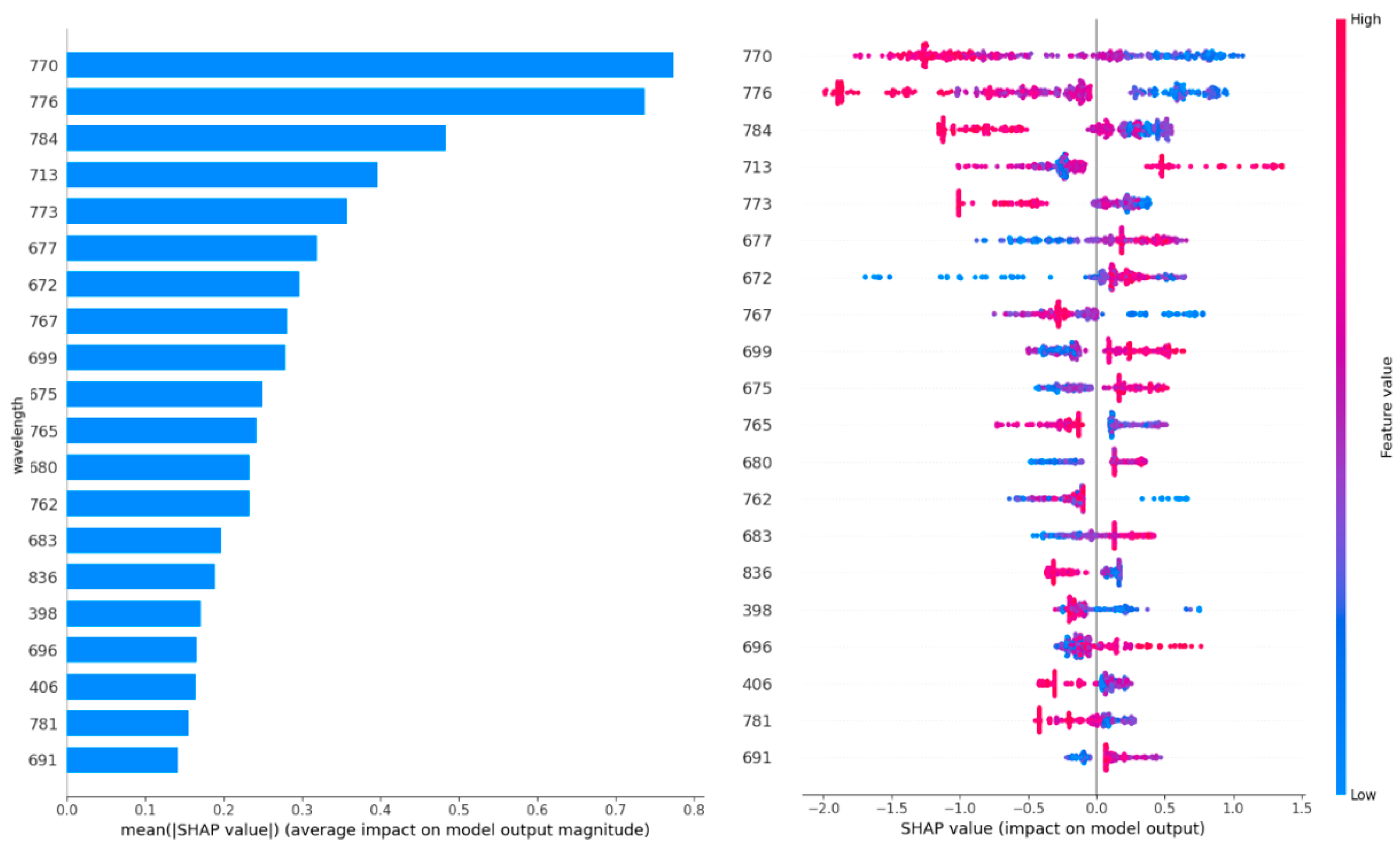
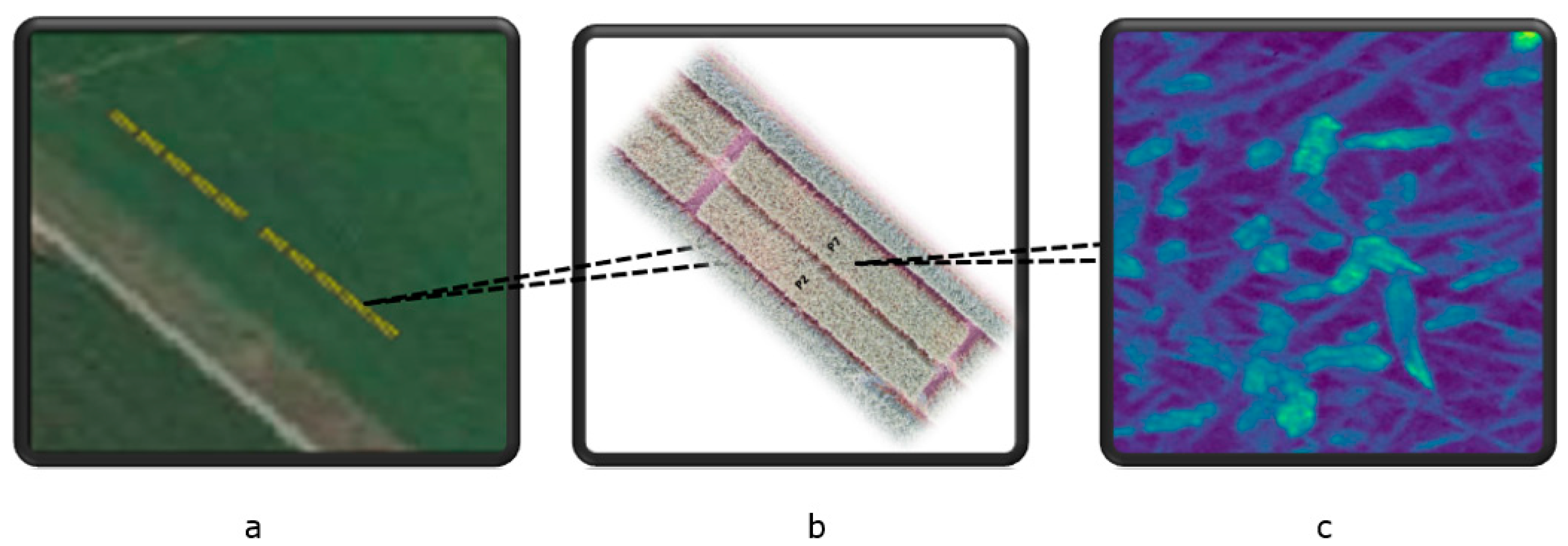
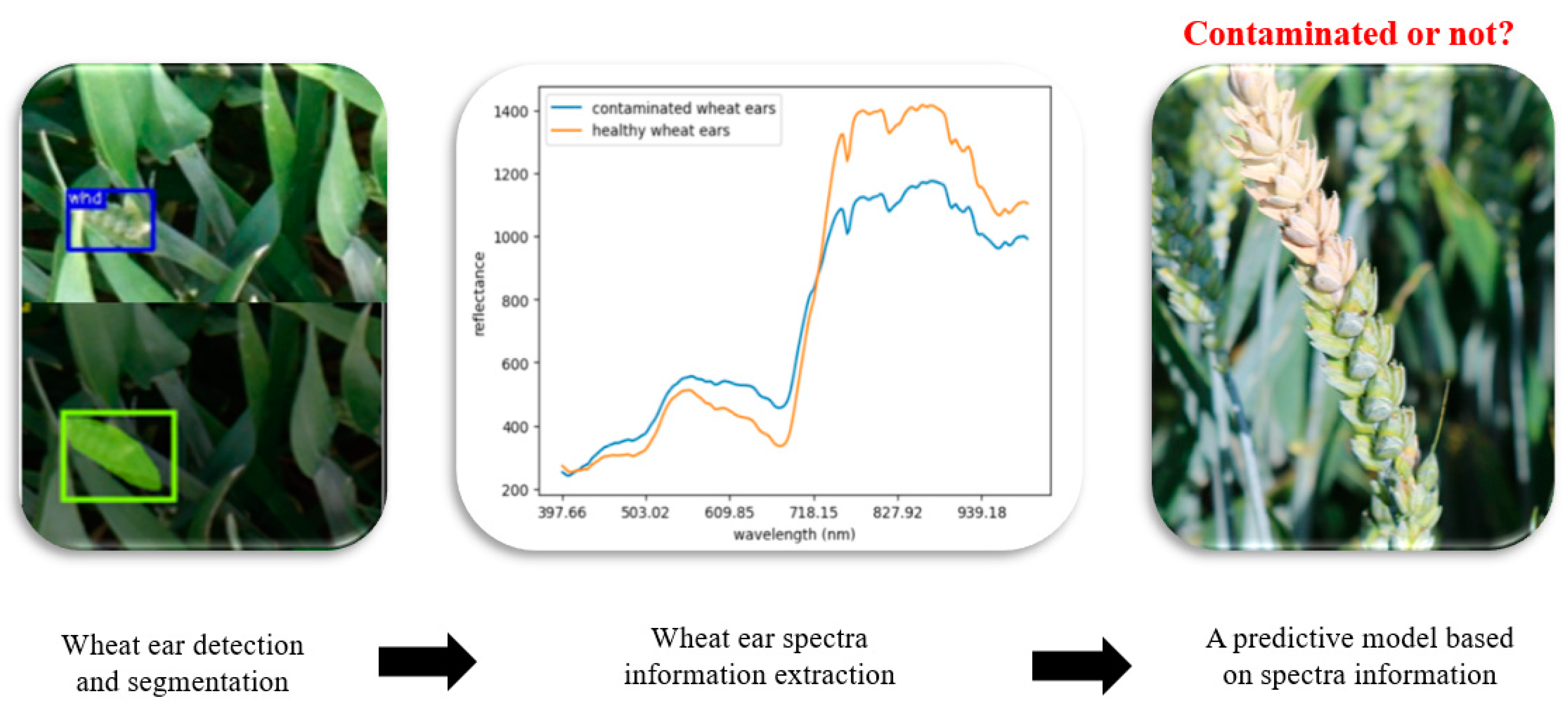
| 5-Folds | Training Accuracy Scores | Mean Training Accuracy | Training Precision Scores | Mean Training Precision | Training Recall Scores | Mean Training Recall | Training F1 Scores | Mean Training F1 Score | Validation Accuracy Scores | Mean Validation Accuracy | Validation Precision Scores | Mean ValidationPrecision | Validation Recall Scores | Mean Validation Recall | Validation F1 Scores | Mean Validation F1 Score |
|---|---|---|---|---|---|---|---|---|---|---|---|---|---|---|---|---|
| 1-Fold | 0.99 | 0.99 | 0.98 | 0.99 | 1 | 0.99 | 0.99 | 0.99 | 0.93 | 0.91 | 0.93 | 0.9 | 0.9 | 0.88 | 0.91 | 0.89 |
| 2-Fold | 0.99 | 0.99 | 1 | 0.99 | 0.98 | 0.99 | 0.99 | 0.99 | 0.93 | 0.91 | 0.96 | 0.9 | 0.86 | 0.88 | 0.91 | 0.89 |
| 3-Fold | 1 | 0.99 | 0.99 | 0.99 | 1 | 0.99 | 1 | 0.99 | 0.9 | 0.91 | 0.82 | 0.9 | 0.97 | 0.88 | 0.89 | 0.89 |
| 4-Fold | 0.99 | 0.99 | 0.98 | 0.99 | 1 | 0.99 | 0.99 | 0.99 | 0.89 | 0.91 | 0.83 | 0.9 | 0.89 | 0.88 | 0.86 | 0.89 |
| 5-Fold | 0.99 | 0.99 | 1 | 0.99 | 0.98 | 0.99 | 0.99 | 0.99 | 0.9 | 0.91 | 0.96 | 0.9 | 0.79 | 0.88 | 0.86 | 0.89 |
Disclaimer/Publisher’s Note: The statements, opinions and data contained in all publications are solely those of the individual author(s) and contributor(s) and not of MDPI and/or the editor(s). MDPI and/or the editor(s) disclaim responsibility for any injury to people or property resulting from any ideas, methods, instructions or products referred to in the content. |
© 2024 by the authors. Licensee MDPI, Basel, Switzerland. This article is an open access article distributed under the terms and conditions of the Creative Commons Attribution (CC BY) license (https://creativecommons.org/licenses/by/4.0/).
Share and Cite
Wang, X.; Polder, G.; Focker, M.; Liu, C. Sága, a Deep Learning Spectral Analysis Tool for Fungal Detection in Grains—A Case Study to Detect Fusarium in Winter Wheat. Toxins 2024, 16, 354. https://doi.org/10.3390/toxins16080354
Wang X, Polder G, Focker M, Liu C. Sága, a Deep Learning Spectral Analysis Tool for Fungal Detection in Grains—A Case Study to Detect Fusarium in Winter Wheat. Toxins. 2024; 16(8):354. https://doi.org/10.3390/toxins16080354
Chicago/Turabian StyleWang, Xinxin, Gerrit Polder, Marlous Focker, and Cheng Liu. 2024. "Sága, a Deep Learning Spectral Analysis Tool for Fungal Detection in Grains—A Case Study to Detect Fusarium in Winter Wheat" Toxins 16, no. 8: 354. https://doi.org/10.3390/toxins16080354
APA StyleWang, X., Polder, G., Focker, M., & Liu, C. (2024). Sága, a Deep Learning Spectral Analysis Tool for Fungal Detection in Grains—A Case Study to Detect Fusarium in Winter Wheat. Toxins, 16(8), 354. https://doi.org/10.3390/toxins16080354






